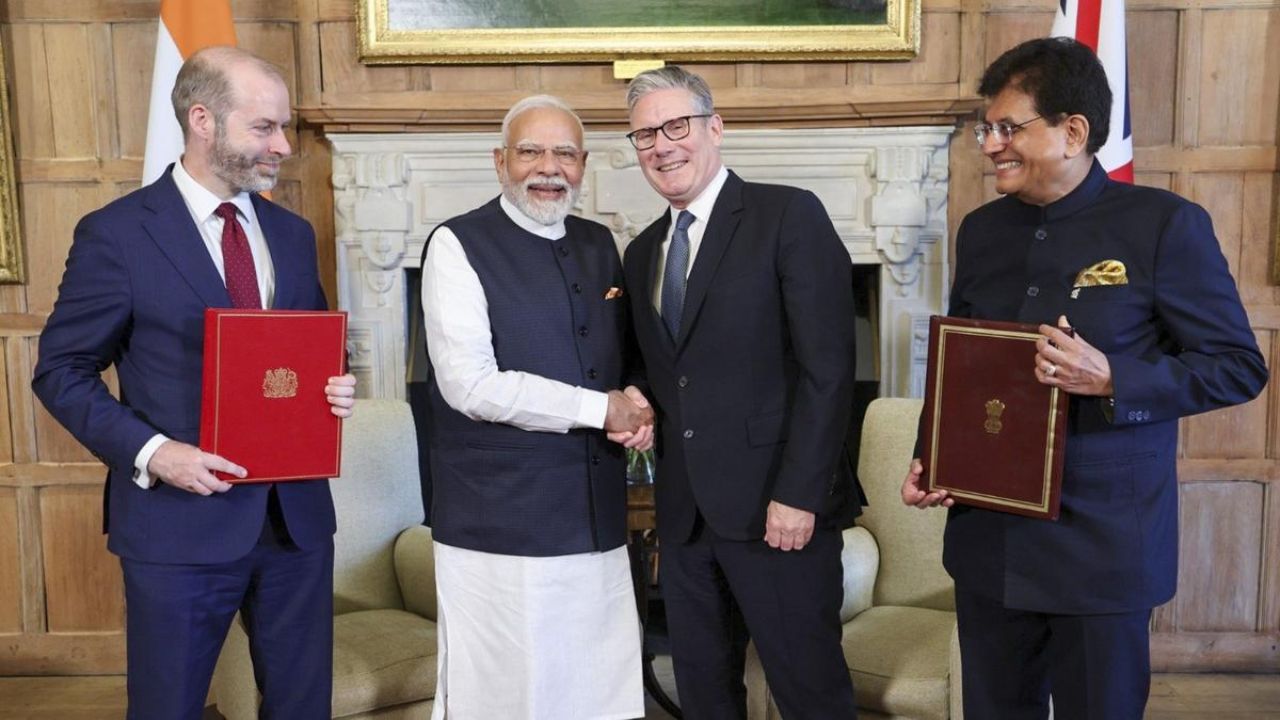In a historic move that’s being hailed as a post-Brexit game-changer, India and the United Kingdom have signed a Comprehensive Economic and Trade Agreement (CETA), unlocking massive economic potential for both nations. But for India, the benefits are especially significant—ranging from zero-duty access for key exports to stronger footholds in global value chains.
Let’s break it down.
🧵 What’s in It for India?
India’s gains in the deal are centered around labour-intensive and MSME-driven sectors—the kind that create the most jobs and exports. Here’s where India scores:
1. Zero-Tariff Access for Key Exports
Indian goods like:
- Textiles & apparel
- Footwear
- Gems & jewellery
- Processed foods
- Marine products
…will now enter the UK either duty-free or with drastically reduced tariffs. For example, UK tariffs of up to 20% on Indian garments and shoes will be eliminated, giving Indian manufacturers a strong edge over global competitors like Bangladesh and Vietnam.
2. Big Boost for Food & Agri Exports
Over 99.7% of India’s agricultural and processed food exports to the UK will now face zero tariffs. That includes:
- Spices
- Tea & coffee
- Marine goods
- Packaged foods
This spells great news for Indian farmers and food processors—particularly in Kerala, Andhra Pradesh, Gujarat, and Tamil Nadu.
3. Support for Artisanal & GI Products
From Kolhapuri chappals to Bhagalpur silk and Kashmiri saffron, India’s traditional and GI-tagged goods now get wider visibility and cost advantages in UK markets.
🚘 What Does India Give in Return?
While India gains on exports, it has agreed to phased tariff reductions on some UK goods, particularly in high-demand sectors:
- Alcohol: Whisky and gin tariffs to drop from 150% to 40% over 10 years.
- Automobiles: Tariffs on high-end UK cars will reduce significantly, though within quotas to protect domestic players.
- Cosmetics & beauty products: Lower import duties, offering more choices to Indian consumers.
The Indian government has protected sensitive sectors such as dairy, edible oils, and apples—ensuring small farmers aren’t impacted by cheaper UK imports.
👩💻 Services & Mobility: A Quiet Revolution
A key win for India is the eased mobility of skilled professionals, including:
- Chefs
- Engineers
- Yoga instructors
- IT consultants
India and the UK also agreed to social security exemptions for Indian professionals working temporarily in Britain, which will prevent double contributions to pension systems for up to three years.
This opens fresh avenues for India’s IT and services exports, already a major strength.
💰 Investment & Procurement Gains
- UK companies can now bid on select Indian government projects (excluding defense and strategic areas), giving them a taste of India’s ₹2 trillion public procurement market.
- Joint announcements confirmed £6 billion in investments across tech, dairy, aerospace, EVs, and renewable energy.
🔎 Why This Deal Matters
| For India | For UK |
| Boosts MSME exports in textiles, footwear, marine, and food | Lower tariffs on whisky, cars, and premium goods |
| Creates jobs in labor-intensive sectors | Easier access to India’s fast-growing market |
| Eases professional mobility to UK | Wins entry into Indian procurement markets |
| Attracts UK investment into Indian manufacturing & tech | Strengthens post-Brexit trade alliances |
With the deal, both countries aim to double bilateral trade—targeting $100–120 billion by 2030, up from ~$60 billion currently.
🛑 Are There Any Risks?
Yes, some challenges remain:
- Indian MSMEs may face compliance pressure due to UK quality standards (e.g. OEKO‑TEX for textiles).
- India must be cautious of import surges in auto, liquor, and chemicals that could threaten local producers.
- The UK’s upcoming carbon tax (CBAM) could impact India’s steel and aluminium exports unless green transitions are made.
But the government has safeguarded vulnerable sectors while betting big on long-term structural gains.
✍️ Final Thoughts
This India–UK trade deal is not just about economics—it’s a strategic milestone. It marks India’s confidence in global trade leadership and its ability to compete with manufacturing giants. For Indian MSMEs, farmers, professionals, and exporters, it offers a gateway to Europe-like markets with fewer barriers and greater opportunity.
The future of “Make in India” just got a massive boost—from London


